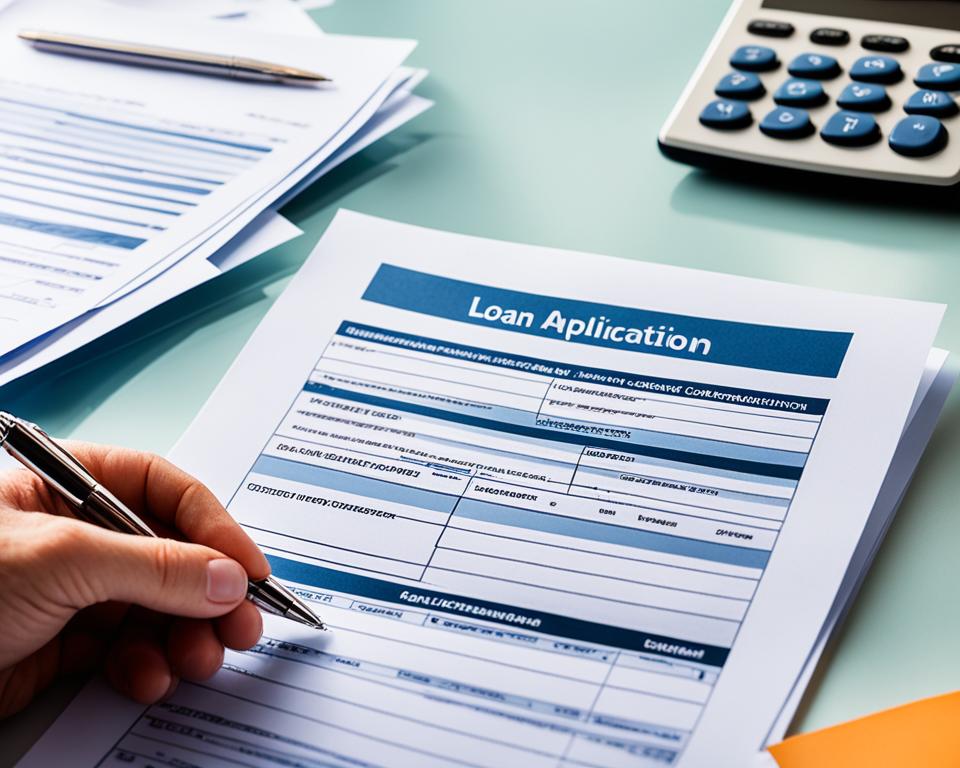Applying for a loan can be a significant financial decision, and understanding the loan application process is essential to increase your chances of approval. Whether you’re looking to fund a new business venture, renovate your home, or consolidate your debts, knowing the steps involved will help you navigate the application process smoothly.
So, what are the key steps in applying for a loan? Let’s break it down:
Determine Your Loan Amount
Before you begin the loan application process, it’s crucial to determine the exact amount you need. Consider your financial goals and calculate the loan amount that aligns with your needs. Using a personal loan calculator can help you experiment with different loan terms and understand the impact of origination fees on your loan amount.
Review Lender Requirements and Gather Documentation
Each lender has specific requirements for loan approval. Research lender requirements ahead of time to understand their eligibility criteria. This may include factors such as credit score, debt-to-income ratio, income verification, and collateral. Gathering the necessary documentation, such as proof of identity, income verification, and proof of address, will streamline the application process.
Consider Your Options
When applying for a loan, it’s essential to consider your options based on your specific needs. Evaluate different loan types, such as personal loans, debt consolidation loans, home improvement loans, or business acquisition loans. Understand the benefits of short-term versus long-term loans, as well as the potential impact on your credit score.
Choose Your Loan Type
Once you’ve considered your options, choose the loan type that aligns with your financial goals and intended use of funds. Each loan type has specific requirements and benefits, so understanding them will help you make an informed decision.
Submit the Application
After choosing the loan type, it’s time to submit the application to a loan officer. Be prepared to provide all the necessary information and discuss your financial details. The loan officer will guide you through prequalification and completion of the application.
Undergo Loan Underwriting
Upon submission, your loan application goes through the underwriting process. The underwriter will assess your creditworthiness, cash flow analysis, and financial details to determine loan approval. They may request additional information or review a credit memo before making a decision.
Close the Loan
If your loan is approved, the next step is closing the loan. During this process, you and the lender will sign the necessary loan documents, and the funds will be disbursed according to the terms and conditions of the loan.
Receive Post-Closing Information
After the loan is closed, you’ll receive post-closing information, including documents related to the loan, instructions for accessing your loan account, and details about making payments. Keep this information handy for future reference.
Understanding the loan application process and following these steps will help you navigate the journey with confidence. By doing your research, gathering the necessary documentation, and choosing the right loan type, you can increase your chances of a successful loan application.
Now that you know the steps involved in applying for a loan, you’re equipped to make informed decisions for your financial needs. Remember, if you have any specific questions or concerns, it’s always best to consult with a financial advisor or loan officer who can provide personalized guidance.
Key Takeaways
- The loan application process involves several steps, including determining the loan amount, reviewing lender requirements, considering loan options, choosing the loan type, submitting the application, undergoing loan underwriting, closing the loan, and receiving post-closing information.
- Determining your loan amount and understanding lender requirements are crucial steps in the loan application process.
- Considering loan options and choosing the right loan type will help meet your specific financial needs.
- Submitting a complete application and undergoing loan underwriting are key to loan approval.
- Closing the loan and receiving post-closing information ensure a smooth transition to loan disbursement and repayment.
Determine Your Loan Amount
Before applying for a loan, it is essential to determine the exact amount you need. This will impact the interest rate, monthly payment, and origination fees charged by the lender. To calculate your loan amount, consider your specific financial goals and borrowing needs.
Loan Amount Calculation:
- Assess Your Needs: Start by assessing your financial situation and identifying the purpose of the loan. Whether you need funds for a major purchase, debt consolidation, or unexpected expenses, understanding the purpose will help determine the appropriate loan amount.
- Calculate Your Expenses: Make a detailed list of all the expenses you need to cover with the loan. Include any outstanding debts, bills, or specific purchases you plan to make. This will give you a clearer idea of the total amount you need to borrow.
- Consider Loan Origination Fees: Keep in mind that lenders may charge origination fees, which are upfront costs for processing the loan. These fees are usually a percentage of the loan amount and can affect the total amount you borrow.
- Use a Personal Loan Calculator: Utilize a personal loan calculator to experiment with different loan amounts, interest rates, and loan terms. This will help you determine the monthly payment amount and compare options to find the most suitable loan for your needs.
Example Loan Amount Calculation:
Let’s say you want to borrow $10,000 for home improvements and the lender charges a 3% origination fee. Using a personal loan calculator, you can calculate the total loan amount:
| Loan Amount | Origination Fee | Total Loan Amount |
|---|---|---|
| $10,000 | $300 (3% of $10,000) | $10,300 |
By considering loan origination fees in your loan amount calculation, you ensure that you have enough funds to cover the expenses while accounting for any upfront costs. Remember to borrow only what you need to avoid unnecessary debt.
Review Lender Requirements and Gather Documentation
When applying for a loan, it is crucial to understand the specific requirements set by each lender. These requirements play a significant role in determining your loan qualification and approval. Lenders typically evaluate various factors, including your credit score, debt-to-income ratio, income verification, and collateral.
Having a good credit score can greatly increase your chances of loan approval. Lenders use your credit score as an indicator of your creditworthiness and financial responsibility. A higher credit score demonstrates your ability to manage debts effectively, making you a more desirable borrower.
Additionally, lenders consider your debt-to-income ratio, which compares your monthly debt obligations to your income. A lower debt-to-income ratio shows that you have sufficient income to meet your financial obligations and comfortably take on additional debt.
Income verification is another critical requirement in the loan application process. Lenders need proof of your income to assess your ability to repay the loan. Depending on your employment type, this may involve providing pay stubs, tax returns, or bank statements.
Collateral may also be required for certain types of loans, such as secured loans. Collateral provides the lender with assurance that they can recover the loan amount if you fail to repay it. Common forms of collateral include real estate, vehicles, or other valuable assets.
Gathering the Necessary Documentation
To streamline the loan application process, it is essential to gather all the required documentation beforehand. This includes:
- Proof of identity: A valid government-issued ID, such as a driver’s license or passport.
- Income verification: Pay stubs, tax returns, or bank statements showing your income for the past few months.
- Proof of address: Utility bills, rental agreements, or bank statements with your current address.
- Employment history: A record of your work history, including previous employers and job durations.
- Education records: Copies of diplomas, certifications, or transcripts if they strengthen your loan application.
By being prepared with the necessary documentation, you can demonstrate your eligibility and increase your chances of loan approval. Remember, each lender may have specific requirements, so researching and understanding them ahead of time can save you time and effort in the application process.
Pro tip: It’s a good idea to create a checklist of all the required documents based on the lender’s requirements. This way, you can ensure you have everything you need before submitting your loan application.
Example of Lender Requirements
| Lender | Credit Score Requirement | Debt-to-Income Ratio Limit | Income Verification | Collateral Requirement |
|---|---|---|---|---|
| ABC Bank | Minimum 650 | Maximum 40% | Payslips for past 3 months | Not required for unsecured loans |
| XYZ Credit Union | Minimum 600 | Maximum 45% | W-2 forms for past 2 years | Required for vehicle loans |
| 123 Online Lenders | No minimum requirement | No maximum limit | Bank statements for past 6 months | Collateral required for all loans |
Keep in mind that these requirements are just examples and can vary from lender to lender. It’s essential to consult with specific lenders or loan officers to understand their individual criteria and documentation needs, ensuring a smooth loan application process.
Image:
Consider Your Options
When applying for a personal loan, it’s important to consider the various options available to you. Each option has its own unique features and benefits, so it’s essential to determine which one aligns with your specific needs and financial goals.
Fast Funding for Immediate Expenses
If you’re in need of quick cash for urgent expenses like medical bills or home repairs, a personal loan can provide fast funding. Unlike traditional bank loans, personal loans often have a streamlined application process and can be approved and funded within a short timeframe. This makes them an ideal choice for those who require immediate financial assistance.
Future Planning
Personal loans can also be used for future planning purposes. Whether you’re planning a wedding, taking a dream vacation, or investing in your education, a personal loan can help you achieve your goals. By borrowing the necessary funds and repaying them over time, you can turn your dreams into reality.
Short-Term vs. Long-Term Loans
When considering personal loan options, you’ll often come across the choice between short-term and long-term loans. Short-term loans typically have a repayment term of one to three years, while long-term loans can extend up to seven years or more. Short-term loans are ideal for borrowers who want to pay off their debt quickly, while long-term loans offer lower monthly payments but a longer repayment period.
Debt Consolidation Considerations
If you have multiple debts with high-interest rates, consolidating them into a single personal loan can help simplify your finances. Debt consolidation loans allow you to combine all your debts into one manageable monthly payment, often with a lower interest rate. This can save you money on interest payments and make it easier to pay off your debt.
Lump Sum vs. Line of Credit
Personal loans can be disbursed in two main ways: as a lump sum or as a line of credit. A lump sum loan provides you with a one-time payout of the loan amount, which you repay over a fixed period. On the other hand, a line of credit gives you access to funds that you can borrow and repay as needed, similar to a credit card. Choosing between these options depends on your specific borrowing needs and financial preferences.
Bad Credit vs. Better Credit
Your credit history plays a significant role in loan approval and interest rates. If you have bad credit, you may still be eligible for a personal loan, but you may face higher interest rates. On the other hand, having better credit can increase your chances of getting approved for a loan and may even qualify you for lower interest rates. It’s important to assess your credit situation and choose a loan option that matches your creditworthiness.
By carefully considering your personal loan options, you can make an informed decision that best suits your financial needs. Whether you need fast funding, are planning for the future, or are looking to consolidate debt, there’s a personal loan option out there for you.
Choose Your Loan Type
When it comes to borrowing money, there are different loan types available to suit your specific financial needs. Whether you’re looking to consolidate debt, pay off credit card balances, finance home improvements, or acquire a business, understanding the various loan options can help you make an informed decision. Let’s explore four common loan types and their respective benefits:
Debt Consolidation Loans
If you’re juggling multiple debts with different interest rates and payment due dates, a debt consolidation loan can provide a convenient solution. By combining all your debts into a single loan, you simplify your finances and often secure a lower interest rate. This can help you pay off your debts faster and potentially save on interest charges. Say goodbye to the hassle of managing multiple payments and hello to a clear path to financial freedom.
Credit Card Refinancing Loans
High-interest credit card debt can be a burden on your monthly budget. By refinancing your credit card balances with a personal loan, you can potentially benefit from a lower interest rate and fixed monthly payments. This allows you to pay off your credit card debt more efficiently, save money on interest charges, and get closer to achieving your financial goals.
Home Improvement Loans
If you have plans to renovate your home, a home improvement loan can provide the funds necessary to turn your vision into reality. Whether you’re remodeling your kitchen, adding an extra room, or upgrading your outdoor living space, these loans offer competitive interest rates and flexible repayment terms. Enhance the comfort, functionality, and value of your home with a loan tailored specifically for home improvement projects.
Business Acquisition Loans
For aspiring entrepreneurs or established business owners looking to expand, acquiring an existing business can be an appealing option. Business acquisition loans offer the necessary financing to purchase an established business, allowing you to take advantage of existing customer bases, market presence, and operational efficiencies. With this type of loan, you can bring your entrepreneurial dreams to life and propel your business forward.
In today’s competitive lending landscape, it’s crucial to choose the loan type that aligns with your financial goals and intended use of the funds. Whether you’re consolidating debt, refinancing credit cards, improving your home, or acquiring a business, there’s a loan option available to suit your needs.
Remember, each loan type comes with its own set of requirements and considerations. Take the time to research and understand the terms, interest rates, repayment schedules, and eligibility criteria associated with each loan type. This will enable you to make an informed decision and select the loan that best fits your specific situation.
| Loan Type | Key Features |
|---|---|
| Debt Consolidation Loans | Consolidate multiple debts into a single loan, potentially securing a lower interest rate and simplifying your payments. |
| Credit Card Refinancing Loans | Refinance high-interest credit card balances with a personal loan, potentially lowering your interest rate and saving on finance charges. |
| Home Improvement Loans | Secure financing for home renovation projects, enjoying competitive interest rates and flexible repayment terms. |
| Business Acquisition Loans | Fund the purchase of an existing business, leveraging its established customer base and operational efficiencies. |
By choosing the right loan type, you can take control of your finances, achieve your goals, and move closer to a brighter financial future.
Submit the Application
Once you have chosen the loan type, it’s time to submit your loan application to a loan officer. The loan officer will be your guide throughout this process, helping you prequalify, complete the application, and provide all the necessary information. It’s important to be prepared to discuss your business, financial details, and future plans with the loan officer to ensure a smooth and complete application submission.
Remember, the loan officer is there to assist you and ensure that your application is accurate and complete. This step is crucial in moving forward with the loan process, so be sure to provide all the requested information and be open to any clarifications or questions that may arise.
Prequalifying for a loan involves a review of your financial profile to determine your eligibility and estimate the loan terms you may qualify for. This step helps both you and the loan officer understand your financial situation better and identify any potential challenges or adjustments that need to be made before proceeding with the application.
Application Checklist
Before submitting your application, it’s important to have all the necessary information and documentation ready. Use this checklist as a guide:
- Personal identification documents, such as your passport or driver’s license.
- Proof of address, such as utility bills or rental agreements.
- Financial statements, including bank statements, tax returns, and proof of income.
- Business documents, if applicable, such as business licenses, registrations, or financial statements.
- Additional documentation that may be specific to your loan type or lender requirements. Check with your loan officer to ensure you have all the necessary information.
Loan Submission
Once you have gathered all the required information and documentation, you can submit your loan application. Your loan officer will guide you through the submission process, ensuring that all required fields are completed accurately.
It’s important to double-check your application for any errors or missing information before submitting it. This helps to minimize delays and ensures that your application is processed smoothly.
Remember, providing accurate and complete application information is crucial for the loan officer to assess your eligibility and evaluate your loan request effectively.

Next Steps
After submission, the loan officer will review your application and documentation. Depending on the complexity of your loan request, this process may take some time. Be patient and remain in contact with your loan officer for any additional information or updates.
Once your application is reviewed, the loan officer will communicate the next steps in the loan process. This may involve further documentation, assessments, or negotiations.
Remember, the loan officer is your primary point of contact throughout this process. Maintain open communication and promptly respond to any requests or inquiries to ensure a smooth loan application journey.
Undergo Loan Underwriting
Once you have submitted your loan application, it enters the loan underwriting process. This is a crucial step where the lender carefully evaluates your creditworthiness, conducts a cash flow analysis, reviews your financial details, and makes a final determination regarding your loan approval.
The underwriter carefully assesses various factors to gauge your creditworthiness, including your credit score, debt-to-income ratio, and overall financial stability. They will also analyze your historical and projected cash flow to determine your ability to repay the loan.
During the financial review, the underwriter meticulously scrutinizes your financial statements, tax returns, bank statements, and any other supporting documents you have provided. They will examine these documents to validate your income and ensure that you meet the lender’s financial criteria.
In some cases, the underwriter may require additional financial information or clarification on certain aspects of your application. This is a standard procedure aimed at gathering all necessary details to make an informed decision.
“The underwriting process is like a financial detective’s work; we examine every piece of information to get a comprehensive picture of the borrower’s creditworthiness and ability to repay the loan.”
Before making a final decision, the underwriter carefully reviews the credit memo, a document summarizing the key details of your loan request. This memo provides the underwriter with a concise overview of your credit history, financial situation, and the purpose of the loan.
Based on the thorough evaluation of your application, the underwriter makes a final determination regarding your loan approval. Once the underwriting process is complete, you will be notified of the decision, and if approved, you can proceed to the next step in the loan process.
Close the Loan
Once your loan is approved, it’s time to close the deal and receive the funds you need. The loan closing process involves signing the necessary loan documents and ensuring that all the required paperwork is complete and accurate. This is also the time when the lender disburses the funds to you according to the loan’s terms and conditions.
Before you proceed with the loan closing, it’s important to have a closing checklist in place. This checklist ensures that you have all the necessary documents and information ready, making the closing process smoother and more efficient. The closing checklist acts as a guide to help you ensure that nothing is missed and that all the required steps are completed.
During the loan closing, you will meet with a representative from the lender who will go through the loan documents with you. The representative will explain the terms and conditions of the loan, answer any questions you may have, and have you sign the necessary paperwork. It is important to carefully review and understand each document before signing to ensure that you are fully aware of the loan’s terms and obligations.
In addition to signing the loan documents, the lender will disburse the funds to you according to the agreed-upon disbursement method. This could be a direct deposit into your bank account, a check, or any other method that you and the lender have agreed upon. Once the funds are disbursed, they are available for you to use as intended.
Remember to keep copies of all the loan documents for your records. These documents serve as important references and provide proof of your loan agreement.
Completing the loan closing process is a significant milestone in your loan journey. It signifies the official agreement between you and the lender and enables the disbursement of funds to take place. By following the closing checklist, reviewing and understanding the loan documents, and ensuring that all requirements are met, you can successfully close your loan and access the funds you need.
Receive Post-Closing Information
After the loan is closed, you will receive important post-closing information that will help you manage your loan effectively. This information includes post-closing documents, instructions on accessing your loan account, and details about making loan payments.
Post-closing documents are vital records that outline the terms and conditions of your loan. They serve as a reference for understanding your rights and responsibilities as a borrower. These documents may include the loan agreement, promissory note, and any additional disclosures specific to your loan.
To access your loan account, you will receive instructions on setting up an online account. Online account access provides convenient and secure management of your loan. Through your loan account, you can view your loan balance, payment history, and other important loan details.
Furthermore, you will receive information about making loan payments. This includes details on how to set up automatic payments, schedule one-time payments, or make payments by mail or through a designated online portal. Understanding your loan payment options will ensure timely and hassle-free repayments.
With these post-closing resources at your disposal, you can stay informed and organized throughout the life of your loan. It is important to review the post-closing documents, set up your loan account, and be proactive in managing your loan payments.
Conclusion
In conclusion, the loan application process is a comprehensive journey that involves various steps and considerations. By understanding and following these steps, borrowers can increase their chances of loan approval and navigate the process with confidence.
Firstly, determining the loan amount is crucial. This step involves calculating the exact amount needed, taking into account factors such as interest rates and origination fees. It’s essential to borrow only what is necessary to avoid unnecessary debt.
Next, reviewing lender requirements and gathering the required documentation is vital. Different lenders have specific criteria, such as credit score, income verification, and collateral, that borrowers must meet. Researching and preparing the necessary paperwork in advance can streamline the application process.
Considering loan options and choosing the right loan type is another important aspect. Personal loans cater to various needs, such as debt consolidation, home improvement, or business acquisition. Considering factors like short-term vs. long-term loans and lump sum vs. line of credit can help borrowers make informed decisions.
Once the loan type is selected, borrowers need to submit the application and undergo the loan underwriting process. This involves providing all necessary information and going through a thorough evaluation of creditworthiness and financial details by the underwriter.
After loan approval, closing the loan involves signing the necessary documents and receiving the funds. Finally, borrowers receive post-closing information, including details about loan payments and account access.
In conclusion, by understanding and following these steps, borrowers can navigate the loan application process successfully. Researching lender requirements, gathering the necessary documentation, and choosing the right loan type are key factors in securing loan approval and achieving financial goals.
FAQ
What steps are involved in applying for a loan?
The loan application process involves several steps, including determining the loan amount, reviewing lender requirements, considering loan options, choosing the loan type, submitting the application, undergoing loan underwriting, closing the loan, and receiving post-closing information.
How do I determine the loan amount I need?
To determine the loan amount, it is essential to understand the exact amount you need and consider factors such as interest rates, monthly payments, and origination fees. You can use a personal loan calculator to experiment with different loan terms and ensure you only borrow what you need to avoid unnecessary debt.
What are lender requirements and how can I gather the necessary documentation?
Lender requirements include factors such as credit score, debt-to-income ratio, income verification, and collateral. It is important to research specific lender requirements and gather necessary documentation like proof of identity, income verification, and proof of address to streamline the application process.
What factors should I consider when choosing a loan?
When choosing a loan, consider factors such as your specific needs, short-term versus long-term loans, debt consolidation options, lump sum disbursement versus a line of credit, and the potential impact on your credit score. Each loan type caters to different borrowing needs, so choose the one that aligns best with your financial goals.
How do I submit a loan application?
To submit a loan application, you need to work with a loan officer who will guide you through the process of prequalifying, completing the application, and providing all the necessary information. Be prepared to discuss your business, financial details, and future plans with the loan officer to ensure a complete application submission.
What happens during the loan underwriting process?
During the loan underwriting process, the underwriter evaluates your application, creditworthiness, cash flow analysis, and financial details to determine the loan’s approval. They may request additional financial information and review the credit memo before making a final decision on your loan request.
What happens during the loan closing?
During the loan closing, you and the lender will sign the necessary loan documents, and the funds will be disbursed as per the loan’s terms and conditions. A closing checklist is used to ensure all required documentation is complete and accurate before finalizing the loan.
What information will I receive after the loan is closed?
After the loan is closed, you will receive post-closing information such as post-closing documents, instructions on accessing your loan account, and details about making loan payments. This information provides valuable insights into the benefits of being a member of a cooperative and how patronage can impact your loan’s interest rate.
What is the conclusion of the loan application process?
By understanding the loan application process and following each step, borrowers can navigate the journey with confidence and increase their chances of loan approval. It is important to research lender requirements, gather necessary documentation, and choose the loan type that best aligns with your financial goals.





